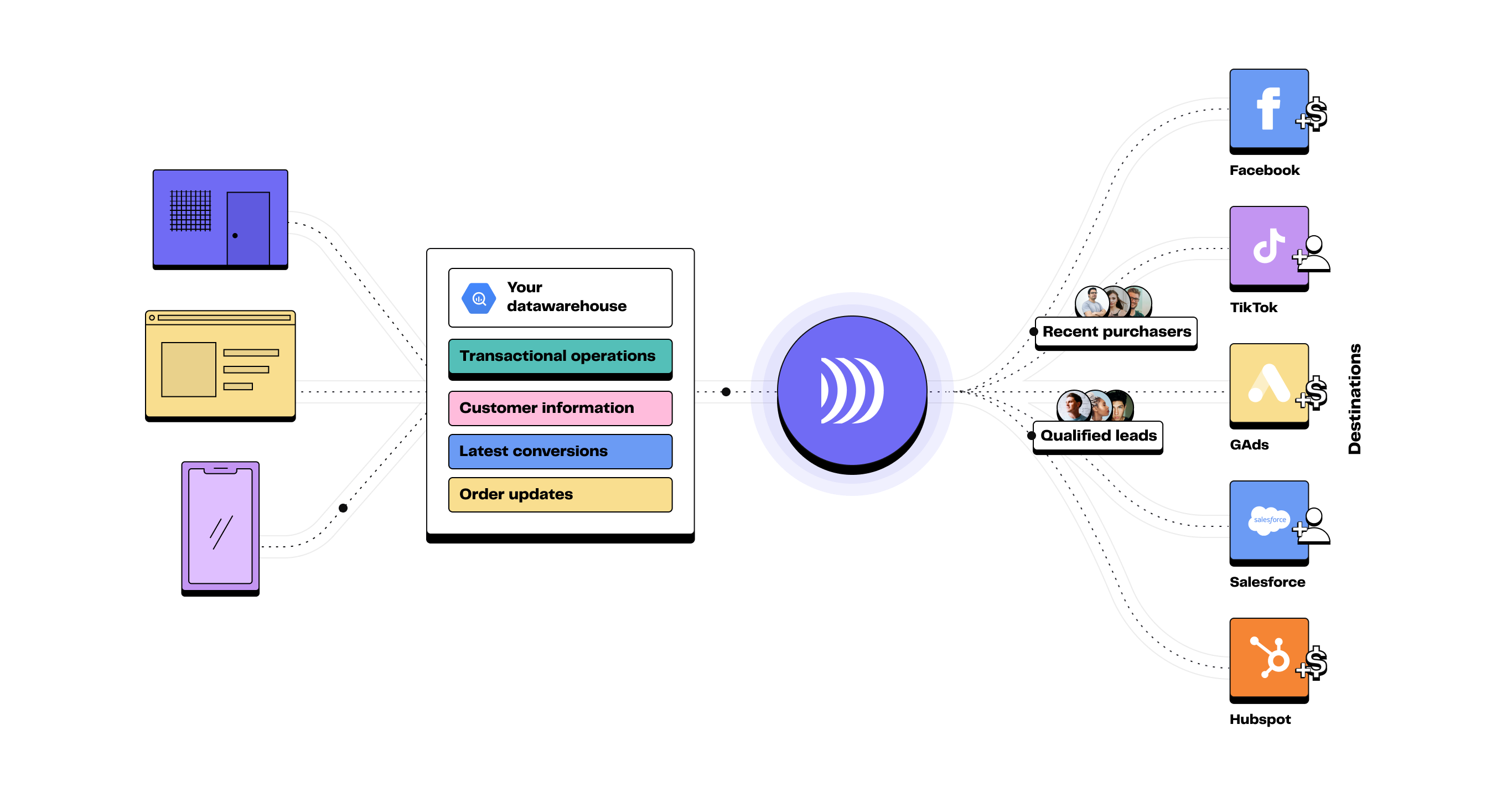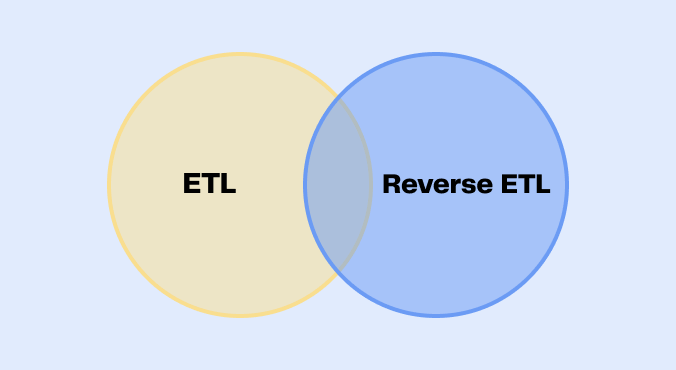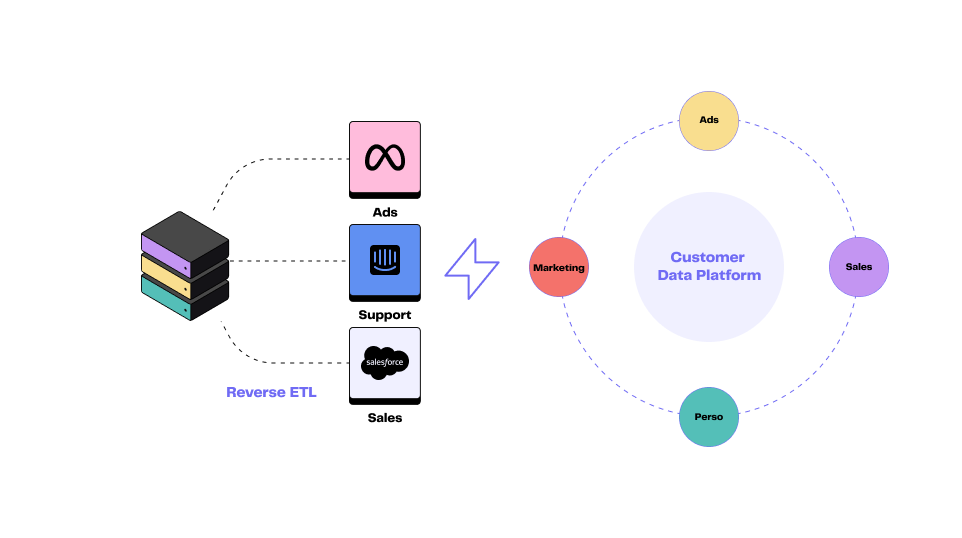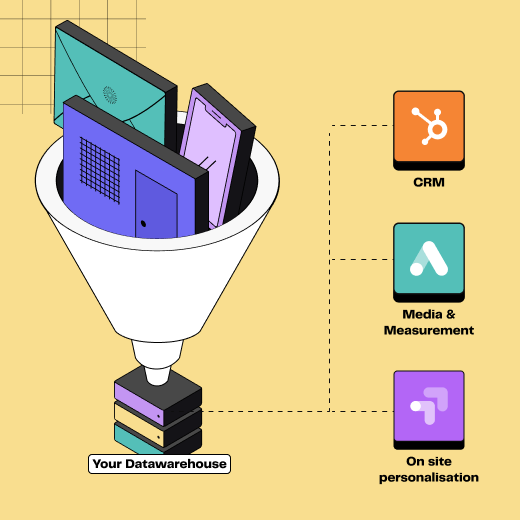
Reverse ETL tools: Choosing the right one
7min • Last updated on Mar 12, 2025

Oussama Ghanmi
Founder, CEO, and CPO
As previously stated on our blog, Reverse ETL tools are transforming the way data is managed by guaranteeing the synchronization of data across numerous business tools and applications. They accomplish this by pushing structured and segmented data from the data warehouse back into the daily operational systems, offering companies valuable insights into customer behavior and enhancing their personalization capabilities.
Choosing the right Reverse ETL platform is important for companies that want to make the most of their data. But with so many options out there, it's tough to know which one is the best fit.
In this article, we'll look more closely at the Reverse ETL tools available to enhance your Modern Data Stack. We'll also talk about what you should think about when picking the right Reverse ETL tool.
What is Reverse ETL?
Reverse ETL refers to the technique of transferring data from a central database, which aggregates data from various sources, into SaaS tools that are utilized by departments such as marketing, sales, support, finance, and operations. This process ensures that business teams have access to up-to-date and comprehensive customer data directly within their operational tools, while also freeing up data teams from the time-consuming task of building and maintaining multiple data pipelines.
This approach supports a range of applications, from enhancing marketing campaigns and sales operations to improving customer support and finance management.
The rise of Reverse ETL has been notable over the past two years, driven by the widespread adoption of cloud data warehouses like Snowflake and BigQuery. As these platforms have become more prevalent, various tools, including CRMs, CDPs, and integration platforms, have begun to integrate with cloud data warehouses. Given this trend, it's important to carefully consider the specific use cases you aim to support with Reverse ETL and to understand the strengths and limitations of each tool available in the market.
Reverse ETL categories
When considering Reverse ETL tools, it's helpful to understand the different categories available, each tailored to distinct needs and operational contexts.
Integration Tools
Tools like Rivery focus on simplifying data movement for engineering teams. They expand the capabilities of traditional ETL by integrating with data warehouses, supporting event tracking, and offering comprehensive integration solutions. These platforms enable engineers to manage all their data integrations in one place. However, their technical complexity means they require significant technical knowledge to operate and are mainly part of the engineering tech stack.
Generalist Reverse ETL Tools
These tools are broader in scope, aimed at solving the challenges data teams face in building and maintaining data pipelines from the data warehouse. They support integration from any source to any destination, such as from a Google Sheet to a database. Examples include Hightouch and Census, ideal for centralized data teams in small to medium companies looking to save time on building connections from the data warehouse. However, the generalist nature of these tools may make them less accessible for non-technical teams due to the need for extensive configuration and understanding of the data model. No-code features, which simplify operation, are often only available in more expensive enterprise plans.
Reverse ETL Tools for Business Teams
This category focuses on enabling non-technical business teams to use data more effectively, without depending on data teams or engineers. These tools may specialize by industry (e.g., SaaS B2B) or function (e.g., marketing teams), offering user-friendly interfaces and simplified user experiences. They support end-to-end implementation of use cases by business teams themselves, using Reverse ETL as a backend process and often providing specialized integrations for the specific teams or industries they serve.
DinMo is at the forefront of this category, specifically designed to empower marketing teams to independently manage customer data segmentation and activation.
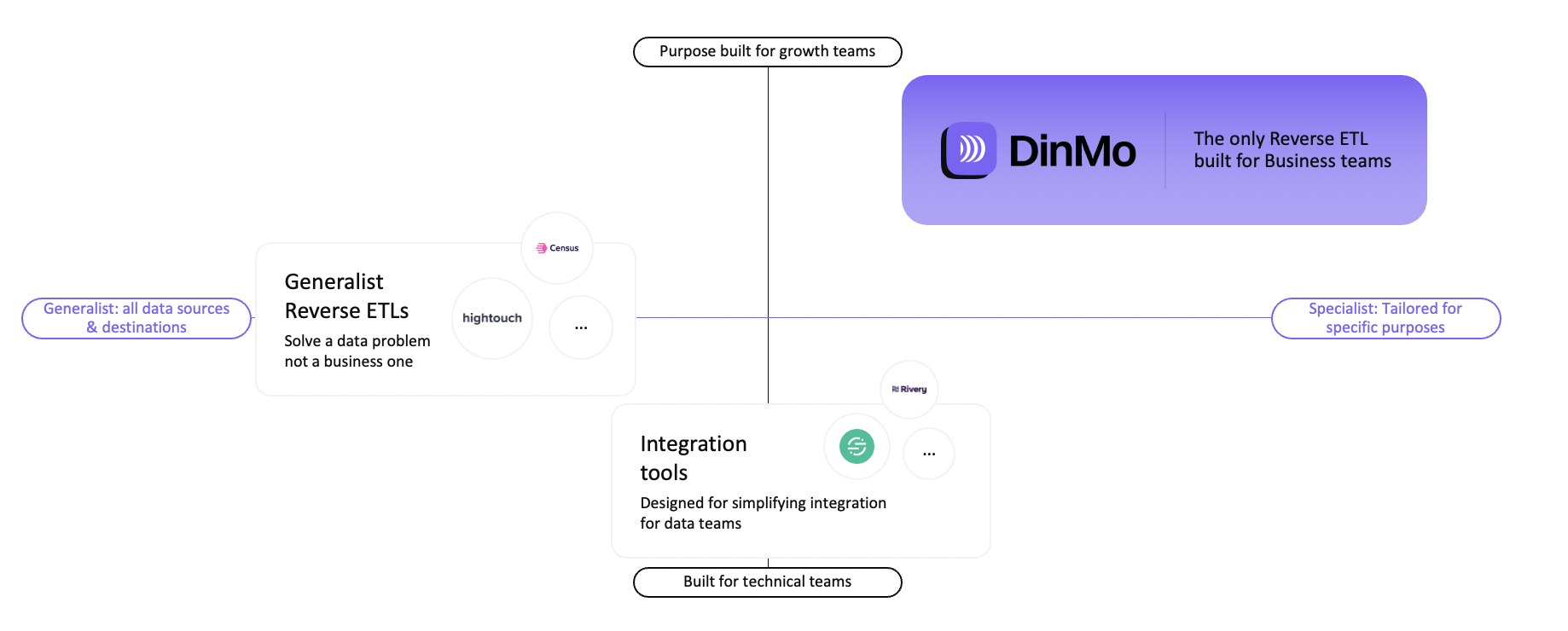
Reverse ETL categories
Most popular reverse ETL
DinMo : Your No-Code Reverse ETL tool
What is DinMo?
DinMo is the Reverse ETL for business teams. While most of our competitors see the problem they solve as one of integration, we go one step further.
At DinMo, we do not only address the needs of data teams but also empower business teams with a tool they can perfectly operate without looping an engineer. We're not just a Reverse ETL tool, but also a complete platform for data activation, transforming your current Modern Data Stack into a true Composable CDP.
Once the configuration has been completed in just a few minutes by your data teams, business teams can prepare and segment customer data in our interface and push back insights in their operational systems in just one click (without any help from the data teams).
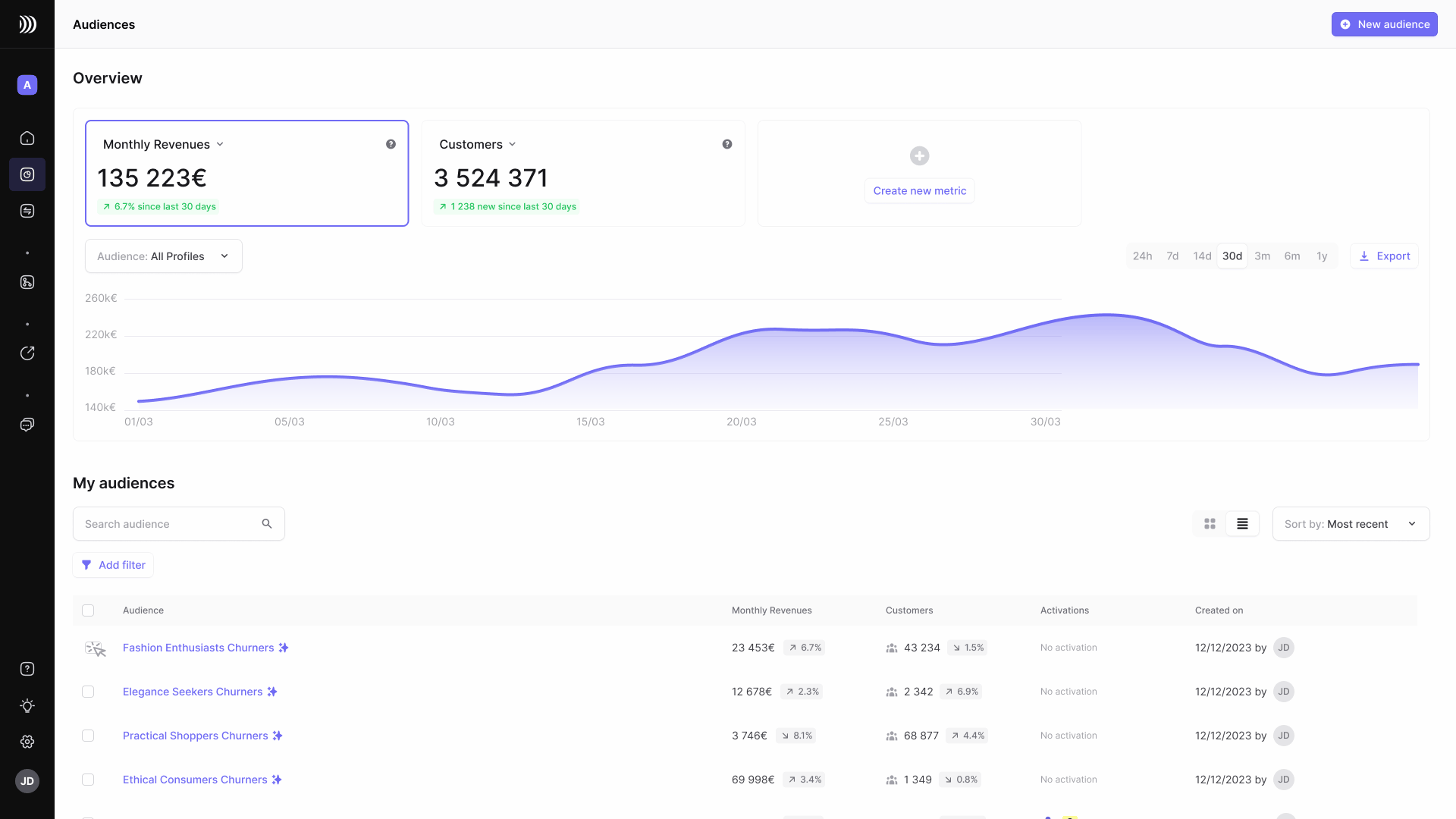
One-click activation
💡 DinMo is the only easy-to-implement data activation platform for non technical teams. At the crossroads of traditional CDPs and Reverse ETL. We combine the:
The no-code UX of the best traditional CDPs for non-technical users
The simplicity and flexibility of reverse ETLs
Key Benefits
At DinMo, we are on a mission to democratize data access and usage for business users so they can help their companies perform better.
Compared to our competitors, we focus on features that can business teams:
Designed by business teams, for business teams: Our no-code UX is largely inspired from leading business tools, so you can get to grips with it straight away.
Complete range of connectors to cover all growth use cases: every use case you can think of is possible thanks to our integrations. From audience strategies to sending conversions and modifying CRM attributes, everything can be sent and implemented on your business platforms.
No-code segmentation functionalities are available for everyone. Any segment can be built without having to disturb anyone in the data team.
Data activation in one click. Any data pipeline can be set up without knowing anything about data and APIs.
Audience performance analytics: Measure everything from sales to number of orders to average basket for a given audience.
Beyond these designed aspects for business teams, our Reverse ETL tool offers several benefits:
AI predictive metrics (lifetime value, churn probability, etc.) to enrich your customer view in your data warehouse and sync it everywhere
Real time data sync
Scalable infrastructure to address big-scale data volumes
Emphasis on data security and compliance with the strictest regulations. DinMo only has read access, meaning that your data always stays in your data warehouse.
Other Reverse ETL tools: DinMo alternatives
Hightouch — The generalist reverse ETL tool for data teams
Hightouch is a generalist reverse ETL for data teams. It syncs data from the data sources to various tools and databases (with more than 200+ integrations).
That being said, DinMo outshines Hightouch in the data activation platform with its non-technical features (user-friendly interface, no-code segment builder, analytics, etc.), available for everyone. Hightouch still requires technical skills for source connection, data modeling, sync mapping, build segment, etc.
Their no-code features are available in a separate product called “Customer Studio” that is only available in Enterprise plans.
Hightouch quickly becomes costly for marketing teams if they want to cover all their use cases, using several integrations and no-code features.
Census — Another reverse ETL tool for data teams
Census is another reverse ETL tool designed for data teams. It is really similar to Hightouch and its no-code features are only available in Enterprise plans.
Census quickly becomes costly for marketing teams if they want to have a complete and self-serve access to their customer data.
Segment — The event collection tool
Originating as a tool for tracking events, Segment has evolved into a Customer Data Platform under Twilio’s umbrella.
It excels in gathering and managing customer data using events collected with their SDK, and more recently, has added reverse ETL functionalities. These functionalities, however, are primarily limited to updating the customer profiles data model within Segment itself.
For pure reverse ETL tasks, the tool currently supports only a select number of destinations. This limitation means that while Segment can be a powerful tool for data integration, it might require additional engineering resources to fully leverage its capabilities in a reverse ETL context.
Segment is still perceived as a technical tool and need an engineer in the loop to be operated.
Rudderstack — The segment alternative
RudderStack simplifies the process of collecting and distributing customer data to the necessary tools and teams. It’s more a Customer Data Integration (CDI) platform than a Reverse ETL tool.
Rudderstack is purpose-built for technical data teams and engineers and only solve the integrations (ELT and Reverse ETL) problems.
If you're a data engineer and in need of integrating mission-critical event data from multiple sources to destinations, this might be your solution. However, if your goal is to give your business teams access to data, this option may not be the best choice (and in that case, we highly recommend you DinMo 🙂)
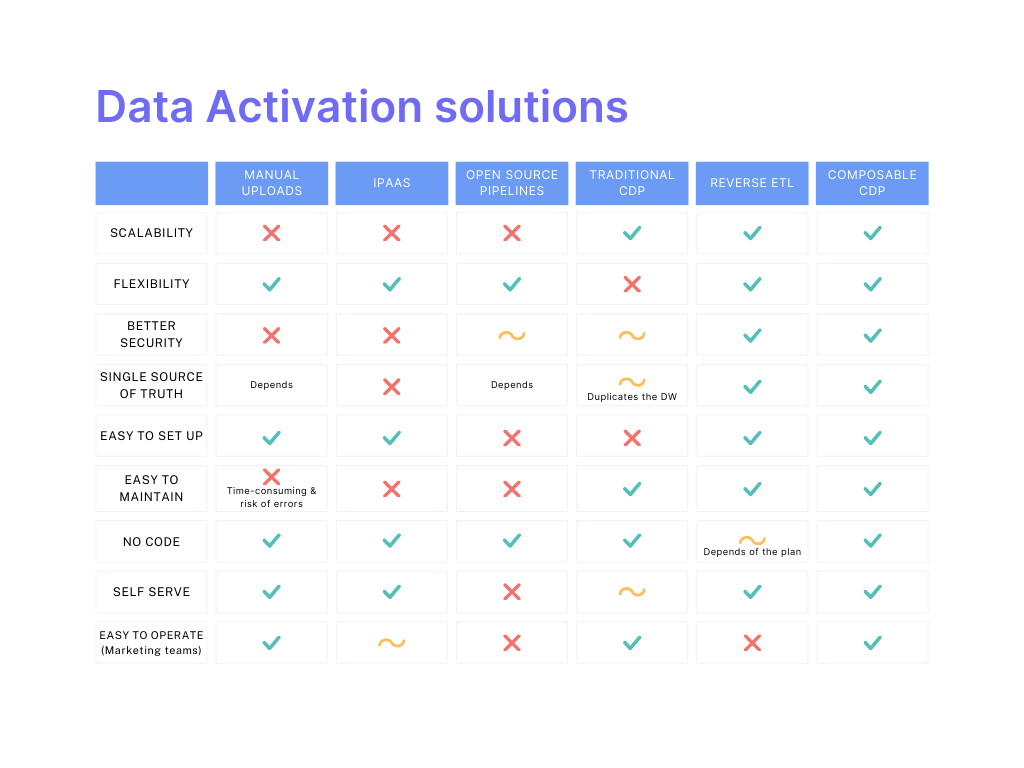
Data Activation Solutions and Comparisons
⚠️ There's little value in building and maintaining pipelines for Reverse ETL
Things to Consider when choosing a Reverse ETL tools
💡 Most Reverse ETL tools have expanded their offering to compete with Traditional CDP vendors. These same CDP vendors have also built Reverse ETL capabilities to expand their product suites. The market for customer data activation platforms is evolving rapidly and adapting your data stack now becomes crucial.
When choosing Reverse ETL tools, several factors should be thoroughly evaluated to find the right fit for your data integration needs. Below is the recommended checklist for selecting your tool:
Support for your existing and future tools: The choice of a Reverse ETL largely depends on the variety of destinations it can integrate with. Ensure it fits with your data stack and your business tools! A destination may only be available from one particular player. For the moment, DinMo is the only Reverse ETL with Batch integration.
Robustness and performance: Choosing a reverse ETL provider that efficiently synchronizes data is critical for speed, reliability, and saving time and costs.
Ease of use: Reverse ETL is designed to save data teams time! Choose a tool that doesn't require engineers to be available to use it.
Ease of implementation: The data model should be flexible and easily configurable by all data warehouse users. The data model must represent the reality of your business and not force you to identify predefined categories.
Observability: A reverse ETL tool should provide robust monitoring capabilities that allow for quick error detection and resolution.
Security: Your chosen provider should have demonstrable compliance with all relevant regulatory requirements (GDPR, CCPA, SOC II, etc.) to ensure the protection of your sensitive data.
Support and Documentation: Data experts and resources (good documentation, tutorials, etc.) must be available to help your team overcome any obstacles.
Scalable Pricing: Of course, pricing is another important factor to consider when choosing a tool: make sure to choose a solution that can scale with your company and your usage. Pay attention to features you may need but are only available in advanced plans!
Conclusion
Reverse ETL is a key component of the Modern Data Stack, transforming how businesses utilize their centralized data for improved data activation. Its role in bridging the gap between data warehouse and business applications makes it an indispensable tool in the current data landscape.
When choosing a Reverse ETL solution for your company, consider the integrations, robustness, the ease of use and implementation, the observability, the security and the dedicated support.
DinMo is the perfect Reverse ETL solution for companies looking for a way to free up time for their data teams and to empower business teams for better overall performance.
Want to see why both marketing and data teams choose DinMo for Reverse ETL? Don’t hesitate to book a demo with us, we’ll be more than happy to discuss!













